During the time Dad was ill, a wave of nostalgia overcame me. Dad was into photography, documenting his travels with mom before and after us kids were born. Inspired by Dad's old but non-functional Asahi Pentax Spotmatic II, I started using film again. My younger brother, Shane, must have had similar feelings because soon after Dad passed, he bought three replicas of the Seiko watch that Dad wore when we were children. Dad loved music and his HiFi audio. I wanted to recreate some of the memorable early Sunday morning experiences Dad and I shared while listening to his records. But I didn't want to spend the kind of money that Dad spent on his gear, and I knew that early morning listening would annoy the rest of the family. I already had a decent set of SR60 headphones from Grado Labs (Brooklyn, New York), and I wanted just enough equipment for a personalised listening experience. I then discovered Schiit Audio.
Founded in June 2010 by two audio veterans, Jason Stoddard (formerly of Sumo) and Mike Moffat (formerly of Theta), Schiit Audio is a leader in affordable high-end audio, with a range of products spanning digital to analogue converters (DAC), amplifiers and preamplifiers, and headphone amplifiers. Schiit Audio products are designed and produced in California (USA), with the majority of parts cost going to US-based companies manufacturing in the USA; the transformers are made in California, circuit boards come from the east coast (of the USA), and Schiit Audio design, assemble, and test everything in Valencia, California. Prices range from $49 to $2399.
Schiit Audio makes two entry-level headphone amps that I think match my Grado Labs SR60: Magni 3+ and Magni Heresy. Magni 3+ is a high-performing discrete current feedback entry-level amp, while Magni Heresy is an all-op-amp design. Magni Heresy improves upon the performance of Magni 3 by another 6-8 dB. Both amps deliver output power 200% higher than many entry-level headphone amps, and both amps are designed and built in California, featuring all-metal construction for $99. I opted for the Magni Heresy, which comes in black and red. Grado Labs makes its headphones in Brooklyn, New York.
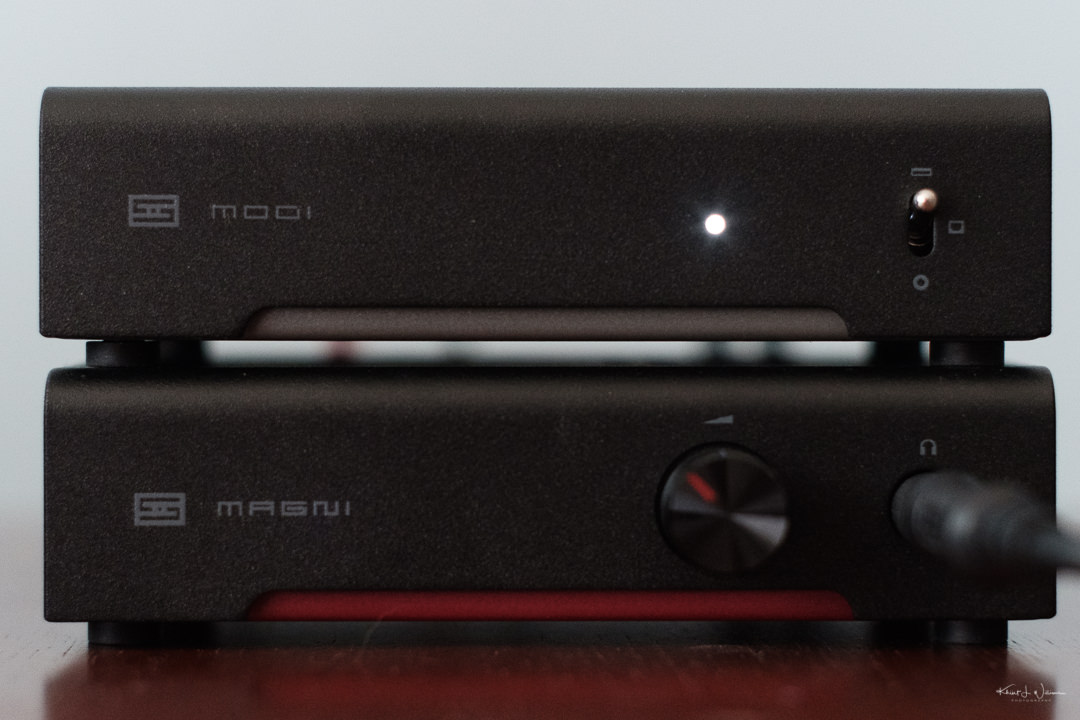
In 2020, Schiit Audio introduced Modi 3+, an updated version of their 3-input DAC. The $99 Modi 3+ adds Schiit's Unison USB™ USB input, a unique high-performance UAC2 digital interface for PCM audio. The Modi 3+ also has optical (TOSLINK) and coaxial digital (RCA S/PDIF) inputs. Modi 3+ is available in black and silver. I opted for black to match the Magni Heresy. All of the geeky technical specs are available on Schiit Audi's website.
When the "Schiit Stack" arrived last week, I quickly set it up on my desk next to my iMac. I connected the Modi 3+ to the Magni Heresy using the 6" RCA PYST cables ($20). PYST is an acronym for "Put Your Schiit Together", referring to the short cables that make stacking the DAC and amp easy. PYST is also the god of drinking in Norse mythology. The Marvel movies have taught me that Thor likes to get "Schiit faced".
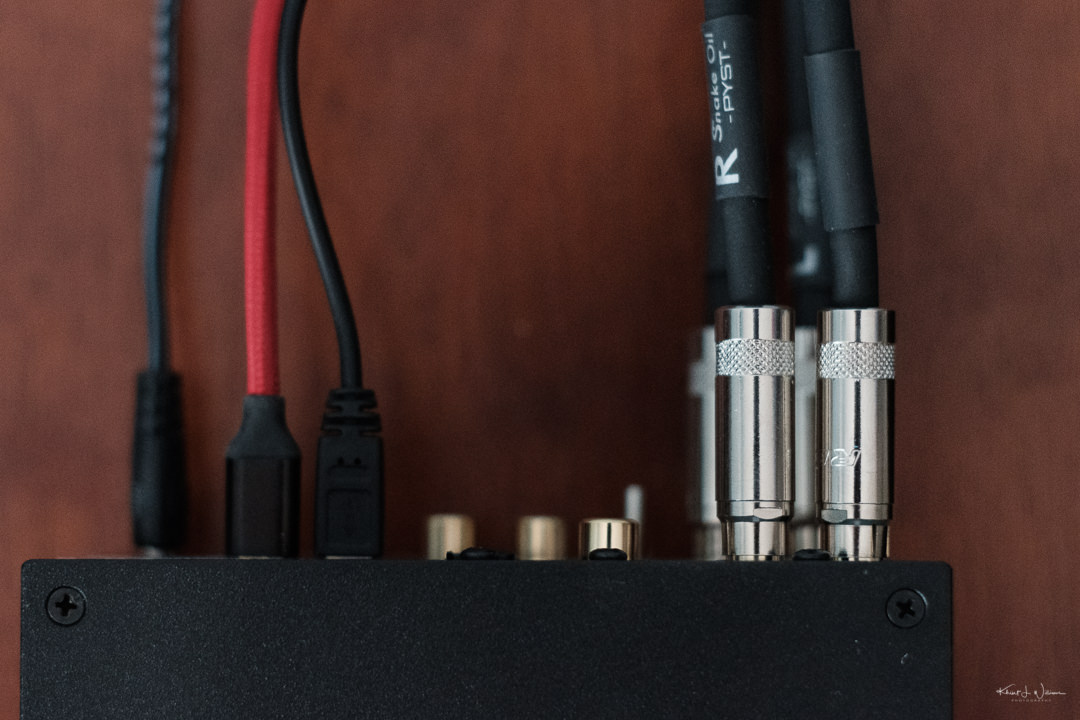
According to the Schiit website:
PYST cables are made from only the finest 6-nines Unobtanium™ alloy, molecularly assembled in our Alternate Universe™ reality-distortion tesseract field, using a secret geometry reverse-engineered from crashed UFOs, painstakingly smuggled out of Area 51 by deep-cover operatives. Performance is further enhanced by the use of a QuantConnect™ quantum-entangled pair of transmission interfaces, held at absolute zero by our exclusive Stasis Field™ technology. The cables are then wrapped in NanoAeroCap™, a nanotechnology-enabled aerogel anti-capacitance insulation system, featuring Fractal Interleaved Geometry™ to create negative inductance for maximum audio transmission quality.
The people who run Schiit Audio must be a fun bunch of people.
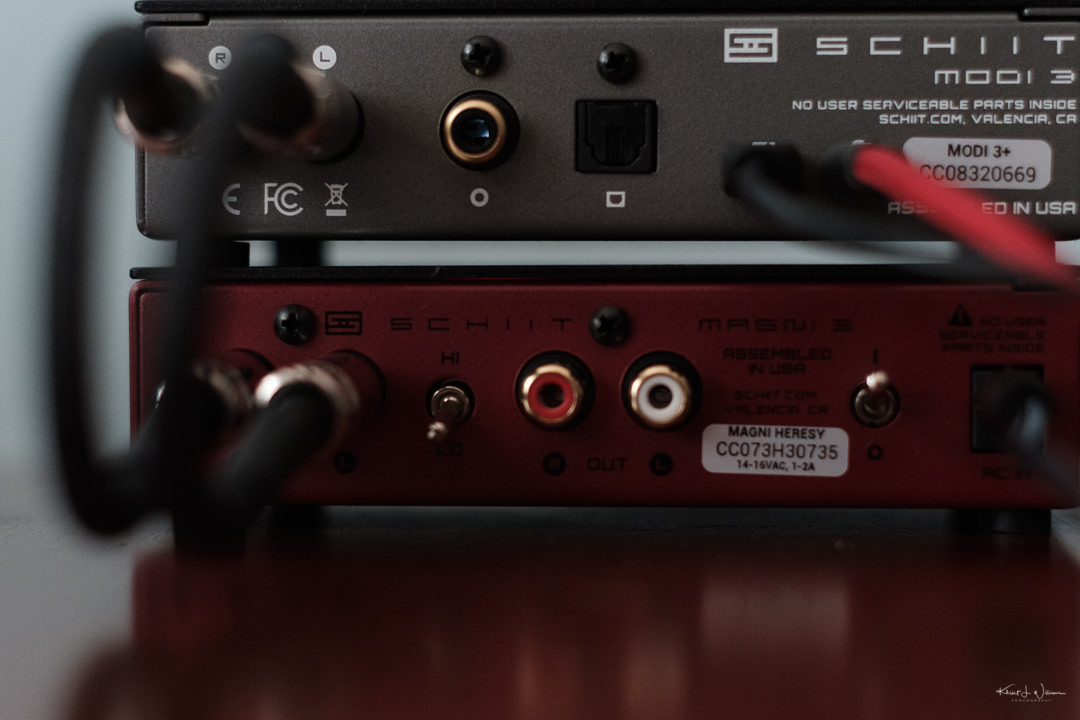
I connected the Modi 3+ to my iMac using a micro USB to USB Type-B cable, powered up the Modi 3+ and Magni Heresy and plugged in my Grado SR60's to the Magni Heresy's headphone jack (using a 3.5mm to 6.3mm adapter), launched Apple Music and queued up one of my favourite playlists.
Years ago, Apple developed a lossless audio compression technology called Apple Lossless Audio Codec (ALAC). Recently Apple encoded the entire Apple Music catalogue using ALAC in resolutions ranging from 16-bit/44.1 kHz (CD Quality) to 24-bit/192 kHz, a marked and noticeable improvement from the compact disk. Over USB, the Modi 3+ processes 24-bit/192kHz audio. That clean, high-res signal is then passed off to the Magni with a pair of RCA cables.
I won't describe the sound with adjectives I don't understand. I'll let others do that. Ian Dunmore wrote in his review of the Magni Heresy.
Heresy offers a reference presentation with a clean, clear, crisp and fast delivery. Tone is neutral, with the overall sound being both rather forthright and on the "lean" or "analytical" side of things. This "analytical" signature also seems to be responsible for at least part of the sense of extremely high agility/transient speed with the Heresy and other, similar, monolithic-based amplifiers.
Timbral rendering is natural, and instruments sound largely lifelike, with appropriate scale, although some, particularly wooden-bodied instruments, like the violin family, felt like they lacked a little body and their natural resonances seem a tad muted. Trumpets, horns (and brass in general) exhibit appropriate bite and glare, though when really pushed their innate brassiness can take on a slightly thin and steely character.
Vocals are nuanced and clear, with their overall tone reflecting the neutral character of the amp, with no apparent emphasis anywhere. Higher-voiced, edgier, female voices sometimes felt a little shrill, but never strayed into sibilance. In fact, I was not able to excite any added sibilance via the Heresy at all, though it certainly doesn't cover any up if it's present in the source material.
In a separate review of the original Modi 3, Ian Dunmore wrote:
Modi 3's general presentation is smooth and refined, with solid tonal density/weight and a good sense of definition and clarity. It learns towards being relaxed or laid-back but does so without giving up any sense of energy or drive to its rendition of music. A little extra roundness in the lower registers comes across as additional bass weight, however there is no sense of "thickness" or "slowness" to the sound, and as I'll come back to shortly - bass articulation and agility is excellent.
...
Vocal tones are natural and nuanced, with good presence. Shoutier, higher-pitched, female vocals do not exhibit any additional sibilance than what is native to the recording, and remain as composed as they can without the DAC editorializing things inappropriately. Annette Strean’s tense, excited, uprising vocal delivery of the first chorus in “Soul Sloshing” (Venus Hum, “Big Beautiful Sky”) is often rather uncomfortable with entry-level converters (and a depressing number of higher-end units too), but is handled with grace and aplomb here - and yet without losing it’s natural edge. This is fall-apart territory for more budget-DACs than it isn’t.
I think what this written adjective abuse means is that the units sound great.
Sitting in front of the iMac to listen to music was uncomfortable. I could use the system while editing photographs or writing, but I was focused on creating an active listening experience. I moved the Schiit Stack to a table in the living room and attempted to connect it to my iPhone 11 Pro. That's when I ran into a challenge. My 2013 iMac has traditional USB Type-B ports. The iMac was easy to connect to the Modi 3+. But the iPhone 11 Pro has a Lightning port. I needed a cable to connect the Lightning port on the iPhone to the micro USB port on the Modi 3+. After unsuccessfully searching Amazon.com and monoprice.com, I enlisted the help of a friend who found a cable on Moon Audio. However, I was impatient. I wanted to listen to music now. I found a solution after sorting through a bag of cables and adapters.
I connected the iPhone 11 Pro to an Apple Lightning USB Camera Adapter. I then attached a micro USB to USB Type-B cable to the female input on the Apple Lightning to USB Camera Adapter and the other end to Unison USB™ USB input in the Modi 3+. Problem solved, right? Nope. The iPhone 11 Pro attempted to draw power from the Unison USB™ USB input, and the setup failed. I needed a way to supply power to the iPhone 11 Pro while sending a digital signal to the Modi 3+. I then remembered that I had such an adapter. The Lightning Audio + Charge RockStar™ from Belkin makes it possible to listen to Lightning Audio while charging an iPhone. So the final setup to connect the iPhone involves a Belkin Lightning Audio + Charge RockStar™ adapter connected to power on one port and the other port, the Apple Lightning to USB Camera adapter connected via USB Type-B to micro USB cable.
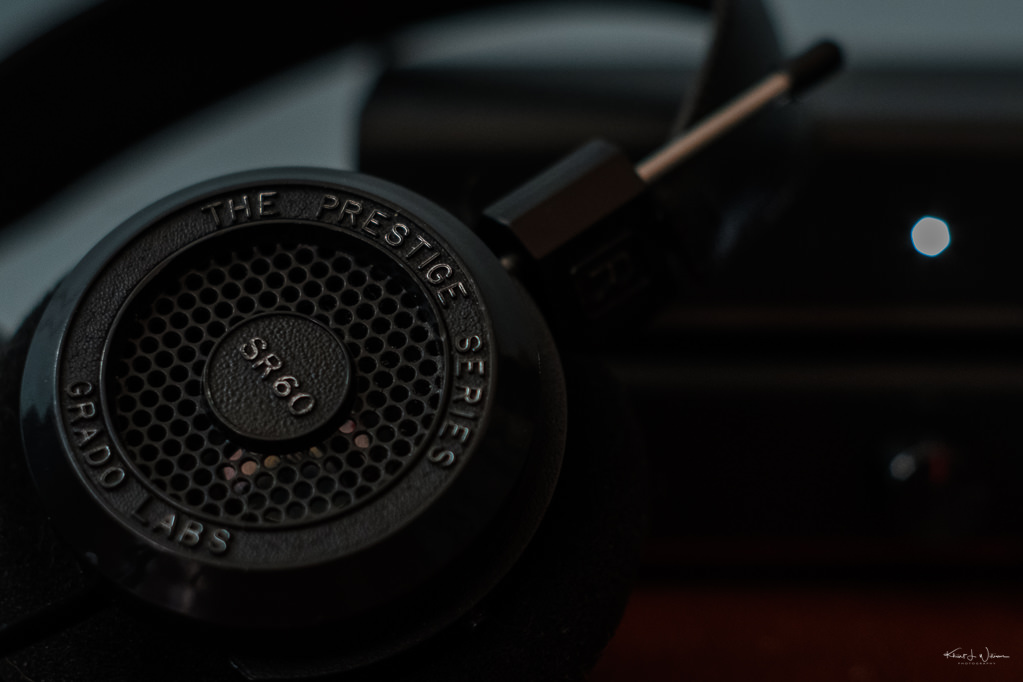
I am thoroughly enjoying the experience. I can hear that the sound from the "Schiit Stack" is better and more enjoyable than the sound from the iMac headphone jack or the iPhone 11 Pro over Bluetooth headphones or via the pigtail adapter1. Yesterday, I sat in a chair in the living room, enjoying a playlist of my favourite Oasis songs. I closed my eyes and imagined Dad was with me, giving his critique. Some of Dad’s favourite albums were Pink Floyd’s Dark Side of the Moon, Fiddler on the Roof soundtrack, and Neil Diamond’s Coming to America. I think I’ll listen to those albums over the coming weekends.
At some point, I would like to get some powered speakers or a vinyl turntable (aka photograph). Schiit Audio makes quality speaker amplifiers, but they are not budget-friendly (at least not for my budget). I prefer a pair of powered book-shelf-size speakers (aka monitors). The Magni Heresy has an RCA output that can connect to the input of power speakers from JBL or Audio Technica. Schiit all sells a 2-input passive preamp with volume control that they have branded SYS. I would connect the Modi 3+ to one of the inputs on the SYS and a phonograph to the other. The output of SYS would connect to the Magni Heresy for headphone use or to powered speakers. The complete kit would not be the vintage system I had imagined, but I think the system's compact size and minimalism are better suited for my "small home" living room space.
- This adapter has a built-in DAC and lets you connect devices that use a 3.5 mm audio plug to Apple devices with Lightning ports. ↩
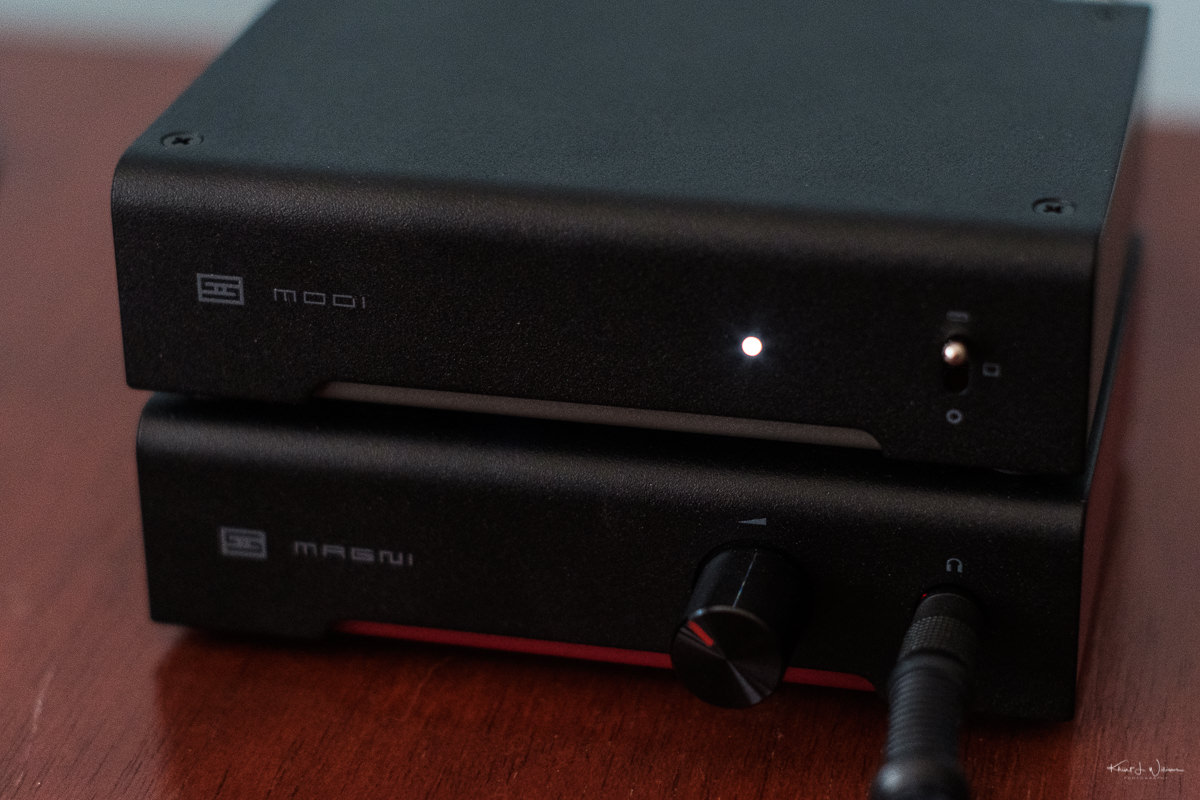

One thought on “Schiit Audio Modi 3+ and Shiit Audio Magni Heresy”